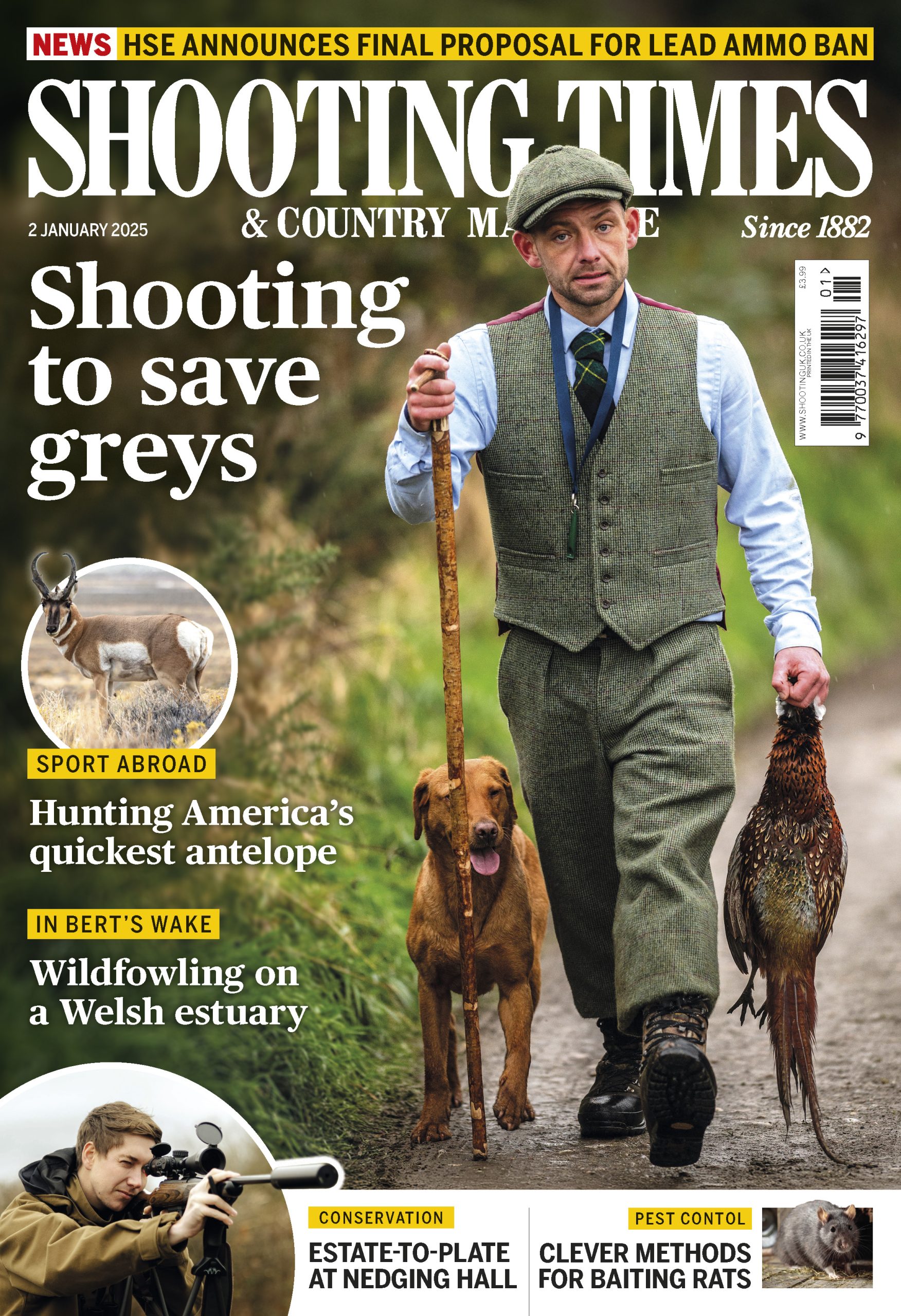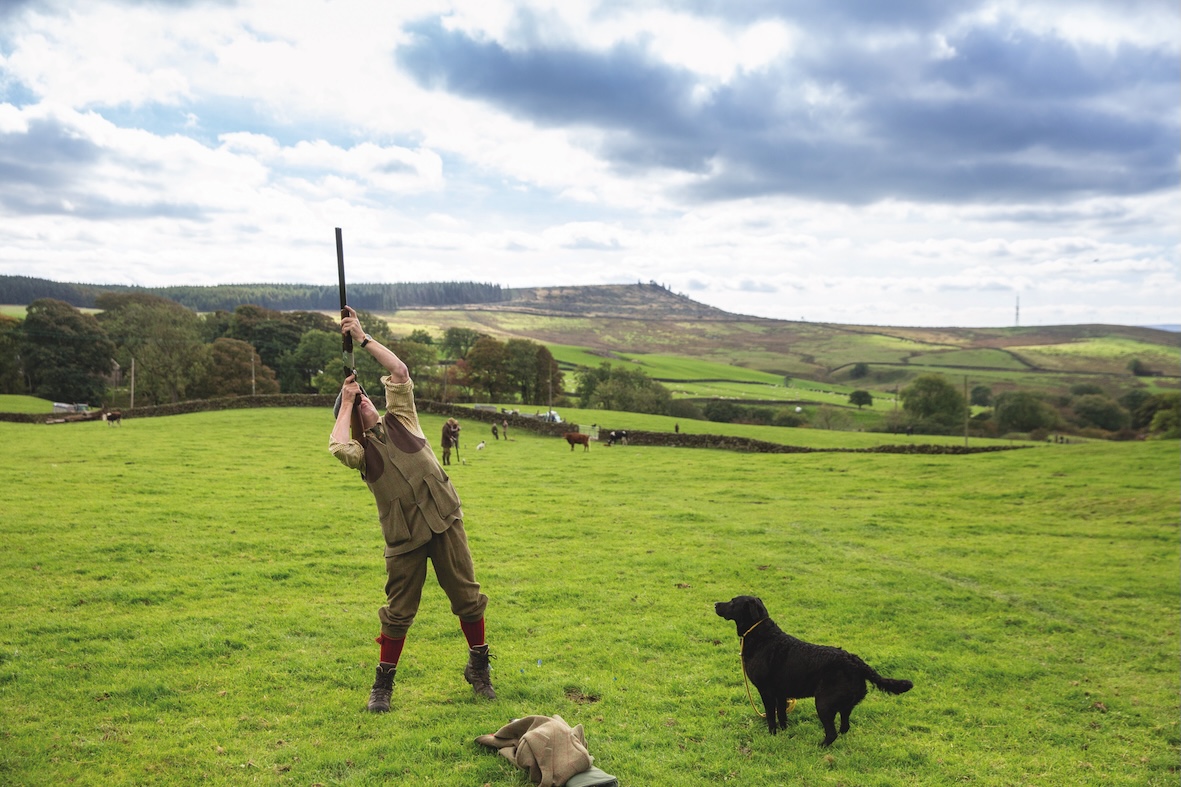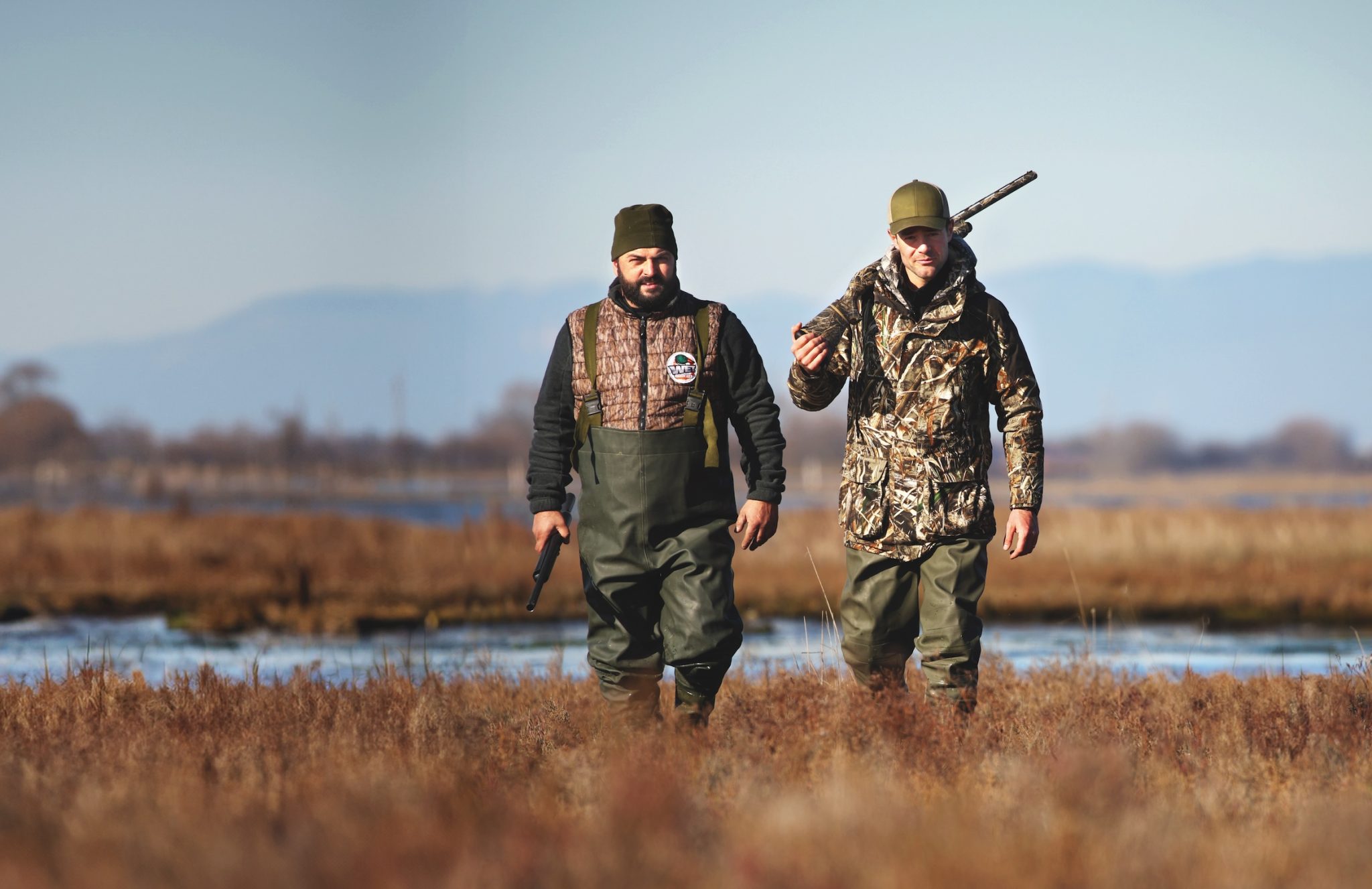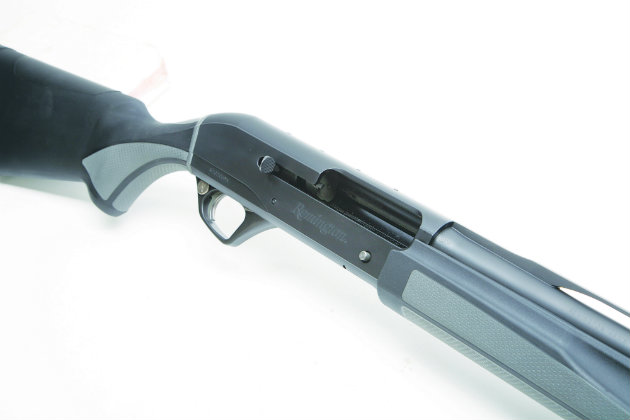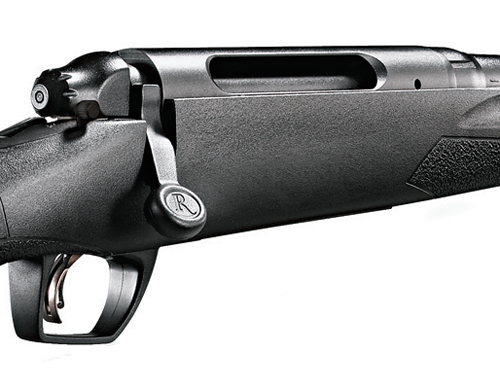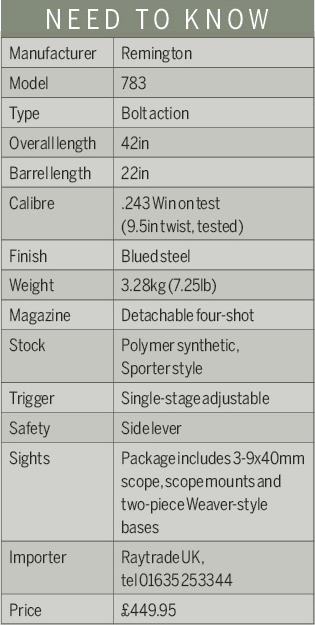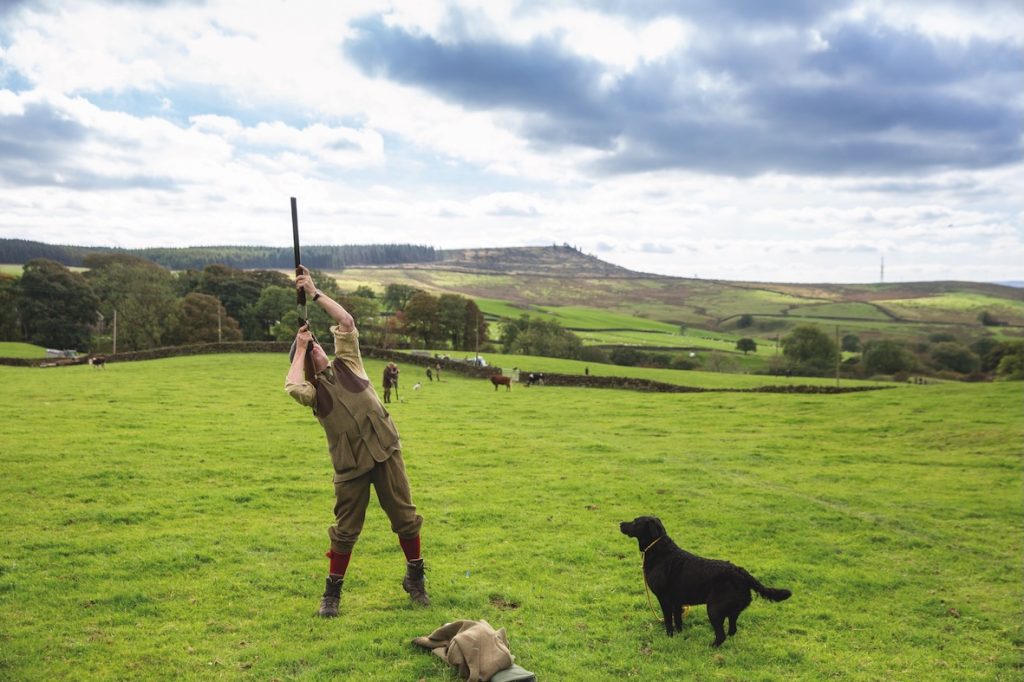Remington 770 stalking rifle: The Remington 770 is an accurate and good all-rounder for a budget stalking rifle.
Win CENS ProFlex DX5 earplugs worth £1,149 – enter here
Remington Model 783 reviewed by Shooting Times
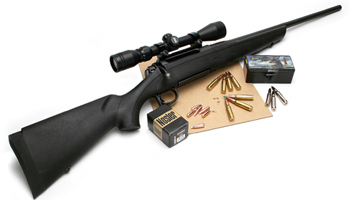
Remington has languished in the shadows for a number of years, which is a shame because in the past the company’s models were the mainstream hunting rifles in Britain alongside those made by Tikka, Sako and Ruger. However, Remington is back, with its rifles and shotguns now distributed by Raytrade, based in Whitchurch, Hampshire, and there is a comprehensive range of models on offer.
Makers are realising the benefits of offering less expensive versions of their rifles or new cost-effective rifles for shooters who want a rifle that shoots well but does not need to be of the highest quality. If companies offer a package of a rifle, scope and mounts, so they can “click and go”, it suits a large number of people and makes economic sense.
More than 10 years ago, Remington offered the Model 770 as a less expensive version of its flagship Model 700 range. I tested the 770 but it never really took off, despite being a good-value rifle. The new Model 783 on test here follows the same lines as the Model 770, but is a far better rifle as it has been designed to shoot accurately and consistently without the frills that are cosmetic and do not affect performance. It is also a nice-looking rifle.
A second-hand Remington Versa Max – what to look out for
Our expert Mike George looks into the second-hand options for a Remington Versa Max
£750.00
Remington launch new 783 bolt-action rifle
Remington launch new 783 bolt-action rifle: Crafted in Remington’s facility in Kentucky, the new bolt-action 783 has a dual-pillar bedding…
The 783 range
There are four models in the 783 range — the standard tested here, a compact, a camo (all with a synthetic stock) and a walnut-stocked version. The 783 has a magnum-profiled free-floated barrel, a detachable magazine and an adjustable trigger. The package on test also includes a scope, mounts and bases.
The barrelled action of the Model 783 has some really nice features. Firstly, the barrel has a larger profile than normal, being semi-magnum profiled, so there is more metal around the bore. This helps to dampen harmonics on firing and increases accuracy potential. The barrel is 22in long with a muzzle diameter of 0.661in, which is threaded for the metric M14/1 with a thread protector. It is very well cut and crowned.
- The barrel has a subdued matt-blued finish to reduce reflections, and it is fairly scratch resistant.
- The bore is a traditional button-rifled affair with six rifling lands and a 1-in-9.5in rifling twist rate, measured, so it should stabilise the heavier 100-gr to 105-gr bullet weights.
- The barrel is also free floated along its entire length, thus allowing consistent vibration on firing and enhancing the accuracy.
- There are no open sights, so this is a scope-option only.
Remington Model 783 Action
- The 783’s action is the usual Remington tubular steel profile with the same finish as the barrel, but it has a barrel locking nut to maintain headspace and, as such, sandwiches the separate recoil lug to the action.
- It gives a good degree of precision and the recoil lug is large and thus beds well into the stock.
- The rounded action top is drilled and tapped for the attachment of the two Weaver-type bases fitted and a large escape port for escaping gases if a primer is punctured.
- The bolt release is a small push-down lever to the left of the action that allows the twin-lug bolt to be removed. These lugs are large and give a good friction fit into the action abutments to maintain a solid lock-up.
- There is a Sako-style extractor to the right bolt lug and a sprung-type plunger ejector in the recessed bolt face. One difference on this model is the flattened bolt knob with a stamped “R”, and the bolt shroud is larger and has a pinched-in rear radius and a firing pin protrusion as a visual indication that the rifle is cocked.
- The safety is a simple lever, with forward for fire and rear for safe. Basically, this is all you need.
- The trigger is surprisingly good as it has a trendy safety blade within the trigger-blade. Called the Crossfire trigger, the inner skeletonised blade has to be depressed to activate the main trigger-blade. It stops accidental discharge from an inadvertent trigger pull.

A good detachable magazine feeds well
Trigger and magazine
Set at 3.5lb at the factory, the trigger is a single unit that is crisp with minimal creep. It is adjustable too, so you can set to your own preference if desired.
I like the detachable magazine. Made from steel with a polymer base and a metal integral release catch, it is simple to use, robust and holds four rounds in the .243 Win cartridge.
When it comes to stocks, most synthetic versions are pretty basic, but the stock of this Model 783 has had some thought put into it. This polymer-shelled stock has a moulded-in black textured finish and moulded-in stippled panels on the pistol grip and fore-end for additional hold.

There is a generous trigger guard
Moulded-in sling-swivel attachments are available and the soft-cell recoil pad is excellent. There is no cheekpiece, so the rifle is ambidextrous in design.
Best of all are the fitted aluminium pillars embedded in the stock, so the stock screws do not crush the stock when tightened to the action. This has the benefit of better bedding for uniform firing, which ultimately translates to better accuracy in all weather conditions. This lack of warpage is the reason most people choose a synthetic stock over a wooden stock.
To the bench
It is always interesting to see how a 24in .243 Win rifle performs ballistically, as we have to meet minimum energy figures for deer and short .243 Win barrels can be an issue with some bullet weights.
This Remington Model 783 has a 22in barrel, but there were no problems as the velocities from the bench test showed healthy accuracy and velocity.
The Geco 105-gr bullets, which are excellent and legal for red deer in Scotland, shot 2,874fps and 1,926ft/lb energy. I had 1.5in three-shot groups consistently. The Hornady 75-gr SST load, which is good for foxes and deer, gave a fast 3,301fps and 1,815ft/lb energy. This shot dead on an inch or thereabouts and has a flat trajectory.

The 783 shot remarkably well on steel out to 300 yards with factory loads and reloads
I like the Winchester 95-gr Nosler Ballistic Tips, as at 2,953fps and 1,840ft/lb energy they are good for deer as well as foxes and gave the best accuracy at 1in at 100 yards. Norma 100-gr Soft Point ammunition gave 2,799fps velocity and 1,740ft/lb energy, with three shots just over the inch.
This shows that bullets or loads can vary a lot in different guns. It is not an issue with the Remington — it is the .243 calibre, as it can be finicky with heavier bullets. The Geco, which is heavier, actually shot well above the legal limit of 1,750ft/lb in Scotland, but the Norma in this rifle was just shy of making the grade despite it being superbly accurate. You will probably find that after a run-in process and as the barrel beds in the velocities will increase anyway, but it is still a valid point to make. Reloads, as always, improve matters and you can tailor-make the rounds to suit your own rifle’s throating chambering dimensions and idiosyncrasies.
- This Remington Model 783 really liked a classic load of Hornady 80-gr Soft Point bullet over 48.5 grains of RL19 powder that achieved 3,338fps for 1,980ft/lb energy and 1in groups.
- An alternative for a heavier deer load would be a 100-gr Sierra Game King with a load of 43.5 grains of H4350 powder for 2,855fps, 1,810ft/lb and 0.85in groups.
- A lighter fox/vermin load for lamping duties was 47.75 grains of RL17 powder and a 55-gr Nosler Ballistic Tip bullet for 3,769fps, 1,735ft/lb and 1.25in groups.

The aluminium pillar bedding in the stock of the Remington Model 783 helps maintain accuracy in all weathers
Testing in the field
The Remington Model 783 does not feel like a gun that costs less than £450. The bolt action feels very solid, while the cases are positively ejected and feed well from the magazine. The scope is average but usable, though I would still replace it.
I shot the 783 with and without a sound moderator. Being a fully-floated barrel, there were no issues with the barrel touching the stock when fitted or when a bipod was fitted from the bench test, as sometimes you can get recoil/rebound jump that hinders accuracy.
The bolt action is typical Remington in feel and soon smoothed up in use as most new guns do. Despite being a plain stock, I actually grew to like the handling and practical nature of it with its total lack of felt recoil.
I had four outings after late-season roe and just drew blanks, with either foxes walking up to us, which I left so as not to spook the deer, or does instead of bucks appearing. I therefore set up various steel plates with cut-out silhouettes at 100, 200 and even 300 yards to test the Model 783’s accuracy.
With the Winchester 95-gr load at 100 yards off the bench I had 1in groups. Out in the field I had 2in groups, so there was 1in of wobble. At 200 yards off the bench and bipod I had 2.5in groups and at 300 yards the 4in kill area on the fox was struck every time.
Conclusion
I was pleasantly surprised at the performance of this economically priced rifle, especially as it includes scope, mounts and bases. While the scope is average and
lets this rifle package down somewhat, with the overall savings made there should
be some money left over to buy a better scope.
Remington has made sure the trigger is good. The barrel is profiled correctly for good accuracy consistently, and the float helps to achieve this. The stock is basic but it works fine for real-world hunting conditions, and at under £450 the Model 783 has to rank as a good value-for-money stalking/fox gun for the budget-conscious shooter.
- Accuracy: Considering the price point, the Model 783 shot well with the lighter .243 bullet weights 17/20
- Handling: Good handling for a budget gun 16/20
- Trigger: It is nice that the trigger is adjustable 16/20
- Stock: Well designed and practical for a hunting rifle 17/20
- Value: The sub-£250 price equals good value for money 17/20
- Score: 83/100
Related Articles
Get the latest news delivered direct to your door
Subscribe to Shooting Times & Country
Discover the ultimate companion for field sports enthusiasts with Shooting Times & Country Magazine, the UK’s leading weekly publication that has been at the forefront of shooting culture since 1882. Subscribers gain access to expert tips, comprehensive gear reviews, seasonal advice and a vibrant community of like-minded shooters.
Save on shop price when you subscribe with weekly issues featuring in-depth articles on gundog training, exclusive member offers and access to the digital back issue library. A Shooting Times & Country subscription is more than a magazine, don’t just read about the countryside; immerse yourself in its most authoritative and engaging publication.
